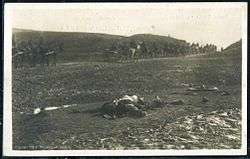Battle of Monastir

| Battle of Monastir | |||||||
|---|---|---|---|---|---|---|---|
 Body of a dead soldier. | |||||||
| |||||||
| Belligerents | |||||||
|
|
| ||||||
| Commanders and leaders | |||||||
| General Petar Bojovic |
Zeki Pasha Fethi Pasha † Djavid Pasha Kara Said Pasha | ||||||
| Strength | |||||||
| 108,544[2] | 38,350[3] | ||||||
| Casualties and losses | |||||||
|
539 killed 2121 wounded[4] |
3,000 killed 5,600 captured 5,000 deserted[5] | ||||||
The Battle of Monastir[6] took place near the town of Bitola, Macedonia[7] (then known as Monastir) during the First Balkan War, from 16 to 19 November 1912. As an ongoing part of the Balkan Wars, the Ottoman Vardar Army retreated from the defeat at Kumanovo and regrouped around Bitola. The Serbian 1st Army, marching for Bitola, encountered heavy Ottoman artillery fire and had to wait for its own artillery to arrive. On 18 November, following the destruction of the Ottoman artillery by Serbian artillery, the Serbian right flank pushed through the Vardar Army. The Serbs then entered Bitola on 19 November. With the conquest of Bitola the Serbs controlled southwestern Macedonia, including the symbolically important town of Ohrid.[8]
Aftermath
After the battle of Monastir, the five-century-long Ottoman rule of Macedonia was over. The Serbian 1st Army continued fighting in the First Balkan War. At this point some Serbs wanted the 1st Army to continue its advance down the valley of the Vardar to Thessaloniki. Vojovoda Putnik refused. The threat of war with Austria-Hungary loomed over the issue of a Serbian presence on the Adriatic. In addition, with the Bulgarians and Greeks already in Thessaloniki, the appearance of Serbian forces there would only muddle an already complicated situation.[8]
References
- ↑ Macedonia: warlords and rebels in the Balkans – Page 29 by John Phillips
- ↑ Hall, Richard C., The Balkan Wars, 1912–1913, (Routledge, 2000), 51.
- ↑ Hall, 51.
- ↑ Hall, 52.
- ↑ Jowett 2011, p. 6.
- ↑ Dupuy, R. Ernest, and Trevor N. Dupuy, The Harper Encyclopedia of Military History, 4th Ed.,(HarperCollins Publishers, 1993), 1016.
- ↑ Hall, 50–51.
- 1 2 Hall, 45–68.
Books
- Jowett, Philip (2011). Armies of the Balkan Wars 1912–13: The Priming Charge for the Great War. Osprey Publishing. ISBN 978-1-78096-528-4.